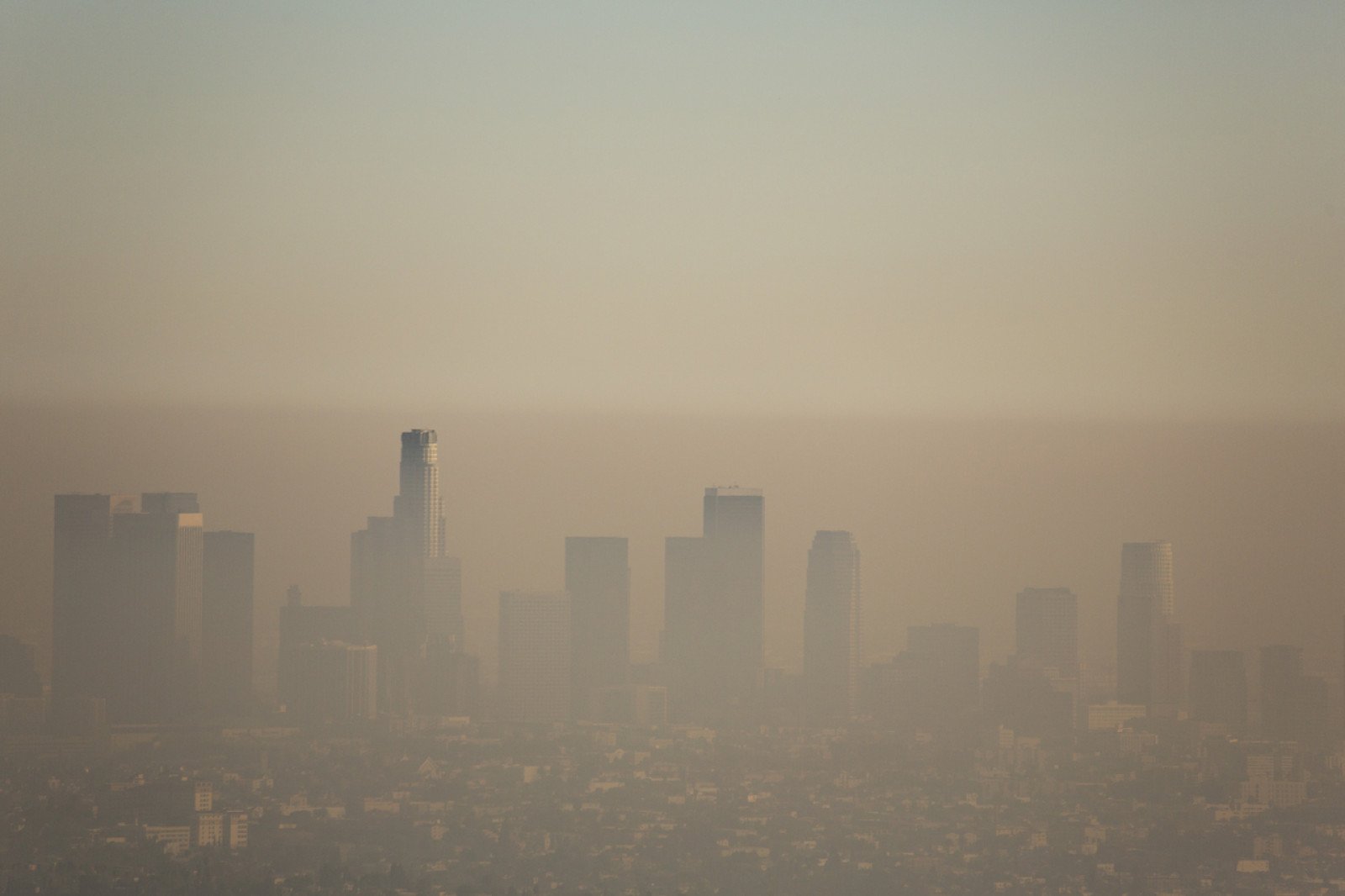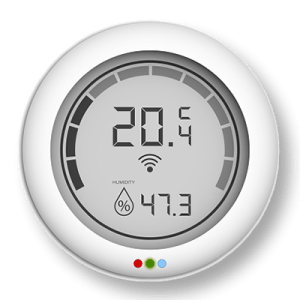Healthy air versus polluted air quality
Discuss air quality and how it can affect quality of life.

Overview
Explore how air quality affects our health through a class discussion and a breathing exercise.
Instructions
What you'll need
- Internet connection and screen to play video
- (Optional) Paper drinking straws
- Ask your students to consider what air is, and what the air quality is like in your community and/or other places they've experienced.
- Have students brainstorm what might make air quality better or worse, either from natural or human causes.
- Ideas to make air quality better include wind, rain, car-free areas, more tree and green spaces, good public transit, bike lanes, and renewable energy.
- Ideas that can make air quality worse include traffic congestion, idling cars, factories, coal plants, forest fires, hot temperatures, and no wind.
- Watch the video "Air Pollution 101" as a class.
- Check the Teaching notes for air quality terms and definitions you may want to discuss with your students.
- After watching the video, ask your students to share ideas on how poor air quality might affect people’s health.
Breathing exercise
Note: Students with respiratory health conditions (such as asthma) should only participate as observers during this exercise.
- Provide each student with a paper drinking straw and ask them to hold it in one hand.
- If straws aren't available, ask students to make a tight fist with one of their hands.
- Ask students to plug their nose using their free hand.
- Now have students place the straw in their mouth and only breathe through the straw.
- If doing the activity without straws, have students place their fist against their mouth, breathing through the small hole created by the thumb and forefinger.
- Have students breathe through the straw or their fist for a few seconds to experience restricted breathing similar to someone with asthma.
- Ask students to stop the breathing exercise and find a partner. Ask each pair to do jumping jacks while taking turns naming things they can do to reduce air pollution. Do this for about 30 seconds to 1 minute.
- Note: jumping jacks can be replaced with running in place, sit ups, or something else that fits accessibility needs.
- Now have students repeat the breathing exercise with their straw or fist again to see what it’s like when you are out of breath and have restricted breathing.
- Discuss how the young, elderly, athletes who play and train outdoors, and people with respiratory or heart conditions are particularly at risk in times of poor air quality.
- Introduce that pollution and air quality are global problems that require global solutions. Below are a few ways that some countries and communities are finding solutions. Have the students share others.
- Cleaning smokestacks and exhaust pipes
- Government laws and regulations
- Replacing non-renewable energy sources with renewable energy sources
- Clean stove projects in developing countries
- Climate change solutions and green technology
- Car-free cities, spaces, and events
Curriculum Fit
Grade 6, 7, 8 Physical Education
Big ideas
- Healthy choices influence our physical, emotional and mental well-being
Grade 6, 7, 8 Physical Education
Curricular competencies
Physical literacy
- Develop, refine, and apply fundamental movement skills in a variety of physical activities and environments
Healthy and active living
- Identify factors that influence healthy choices and their potential health effects (Grade 7, 8)
Grade 7 Science
Big idea
- Earth and its climate have changed over geological time
Curricular competencies
Questioning and predicting
- Identify a question to answer or a problem to solve through scientific inquiry
Grade 6, 8 Socials Studies
Big idea
- Complex global problems require international cooperation to make difficult choices for the future (Grade 6)
- Changing ideas about the world created tension between people wanting to adopt new ideas and those wanting to preserve established traditions (Grade 8)
Curricular competencies
- Ask questions, corroborate inferences, and draw conclusions
Assessments
- Assess students’ ability to share ideas, and listen to each other.
- Assess students’ participation and cooperation in class discussions and jumping jacks.
- Assess students’ understanding of the impacts of poor air quality on health.
Teaching Notes
Air pollution affects the respiratory system (lungs and airways), cardiovascular system (heart function and blood circulation) and major organs (heart and lungs). As air pollution increases it becomes harder to breathe. The respiratory system can become irritated, which may trigger asthma attacks and cause lung disease. Poor air quality can also make existing heart and lung conditions worse and possibly cause premature death.
While poor air quality affects everyone, people who are in the high-risk category are affected to a higher degree. This includes children, the elderly and those with pre-existing cardiac (heart) and respiratory diseases such as coronary artery disease (angina or heart attack), heart rhythm problems, heart failure, chronic pulmonary disease and asthma.
- The World Health Organization estimates that in 2016, 4.2 million premature deaths around the world were linked to air pollution
- Air pollution can cause heart disease, stroke and respiratory infections in children
- In 2016, 91% of the world population was living in places where the WHO air quality guidelines levels were not met
- Canada has the 3rd highest rate of childhood asthma linked to air pollution - 450 per 100,000
Airsheds are geographical areas where the air confined or channelled, often by landscaped features like mountains. The air can become stagnant or polluted.
Volatile organic compounds (VOCs) carbon-containing compounds (natural and synthetic) such as gasoline fumes, paints and solvents.
Nitrogen oxides (NOx) are gases composed of nitrogen and oxygen. The largest source of nitrogen oxides is fossil fuel combustion from cars.
Ground level ozone is a colourless and highly irritating gas that forms just above the Earth's surface. It occurs when nitrogen oxides and volatile organic compounds react in sunlight and stagnant air.
Energy generation is the number one cause of air pollution and one of the leading causes of greenhouse gas emissions.
- Coal is a non-renewable fossil fuel. Coal is the dirtiest burning of the fossil fuels, producing soot, smog, acid rain, global warming, and high carbon emissions.
- Petroleum (oil and gas) is a non-renewable fossil fuel. Refining petroleum creates air pollution and turning crude oil into petrochemicals releases dangerous toxins into the atmosphere. Carbon dioxide is released when gasoline burns.
- Wood fireplaces: Wood is a renewable resource if the forest is managed sustainably. However, the smoke and soot from burning wood are a significant source of air pollution. The burning of wood releases fine particulates, nitrogen oxides, sulfur oxides, carbon monoxide, volatile organic compounds, dioxins, and furans. Some research is showing that burning wood can cause more pollution than burning coal.
- Natural gas is a non-renewable fossil fuel that also contributes to air pollution and has environmental and health risks. Although carbon emissions from burning natural gas are lower than with coal and oil, the drilling, extracting and transportation of natural gas, which is primarily methane, often results in methane leakage, which is 35x more potent than carbon dioxide at trapping heat.
- Biomass: Wood pellet stoves are generally made from compacted sawdust, so they are considered renewable. High efficiency wood pellet stoves have very high burn efficiencies and that combined with the pellet density result in very low particulate emissions, and less greenhouse gases than fossil fuels.
- Nuclear is a renewable energy but it’s not entirely clean. Although it’s emission-free, it results in radioactive, high-level waste (HLW), which needs to be dealt with safely. Nuclear power also requires the mining of uranium, an environmentally and health hazardous process.
- Solar is a renewable energy source that does not produce air pollution. However, the primary material currently used for solar cells is silicon derived from quartz. The quartz is mined and heated in a furnace, resulting in sulfur dioxide and carbon dioxide emissions.
- Wind is a clean renewable energy source producing no air pollution. Wind turbine design has changed significantly in the last few decades to reduce the impact on bird and bat mortality.
- Hydropower is a clean renewable energy source. However, there are environmental impacts to building hydroelectric dams, as they can harm fish populations, change water temperature and flow, and can cause the relocation of people and animals who live near the dam site. With a careful environmental planning process, many of these impacts can be reduced.
- Geo-exchange is a clean energy source that takes advantage of the fact that the ground temperature approximately 0.75m from the surface is fairly constant through both winter and summer. The heat from the ground is used in the winter and the system reverses in the summer to take cool air from the ground.
Read more information on B.C. air quality and airsheds here.







